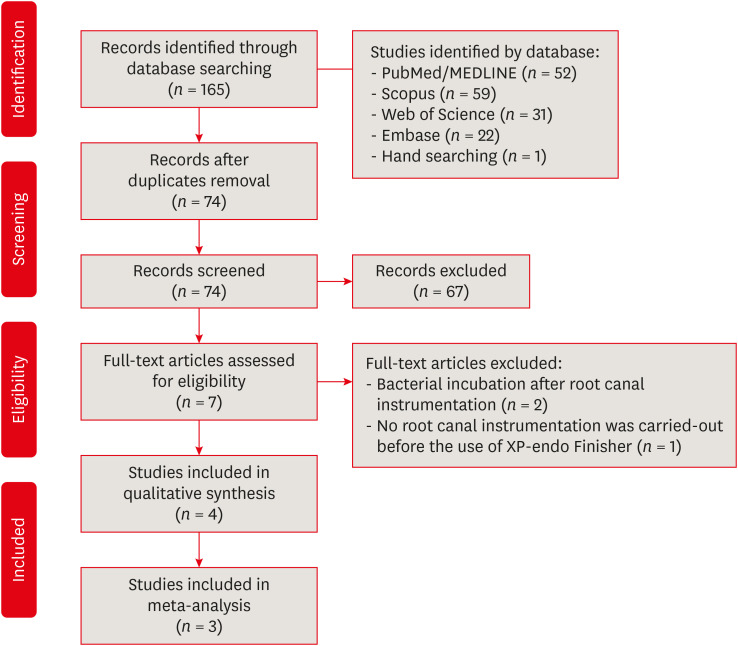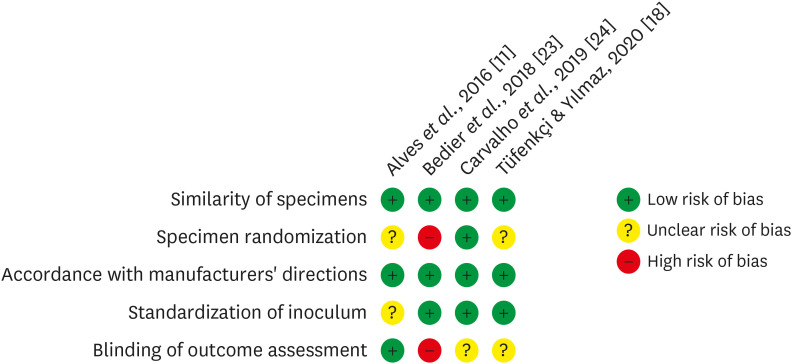Restor Dent Endod.
2021 Aug;46(3):e37. 10.5395/rde.2021.46.e37.
The effectiveness of the supplementary use of the XP-endo Finisher on bacteria content reduction: a systematic review and meta-analysis
- Affiliations
-
- 1Graduate Program in Health Sciences, Federal University of Sergipe, Aracaju, Brazil
- 2Graduate Program in Dentistry, Federal University of Sergipe, Aracaju, Brazil
- 3Graduate Program in Dentistry, IMED - Faculdade Meridional, Passo Fundo, Brazil
- KMID: 2548081
- DOI: http://doi.org/10.5395/rde.2021.46.e37
Abstract
Objectives
This systematic review evaluated the efficacy of the supplementary use of the XPendo Finisher on bacteria content reduction in the root canal system.
Materials and Methods
In-vitro studies evaluating the use of the XP-endo Finisher on bacteria content were searched in four databases in July 2020. Two authors independently screened the studies for eligibility. Data were extracted, and risk of bias was assessed. Data were meta-analyzed by using random-effects model to compare the effect of the supplementary use (experimental) or not (control) of the XP-endo Finisher on bacteria counting reduction, and results from different endodontic protocols were combined. Four studies met the inclusion criteria while 1 study was excluded from the meta-analysis due to its high risk of bias and outlier data. The 3 studies that made it to the meta-analysis had an unclear risk of bias for at least one criterion.
Results
No heterogeneity was observed among the results of the studies included in the metaanalysis. The study excluded from the meta-analysis assessing the bacteria counting deep in the dentin demonstrated further bacteria reduction upon the use of the XP-endo Finisher.
Conclusions
This systematic review found no evidence supporting the supplementary use of the XP-endo Finisher on further bacteria counting the reduction in the root canal.
Keyword
Figure
Reference
-
1. Gomes BP, Lilley JD, Drucker DB. Variations in the susceptibilities of components of the endodontic microflora to biomechanical procedures. Int Endod J. 1996; 29:235–241. PMID: 9206439.
Article2. Siqueira JF Jr, Araújo MC, Garcia PF, Fraga RC, Dantas CJ. Histological evaluation of the effectiveness of five instrumentation techniques for cleaning the apical third of root canals. J Endod. 1997; 23:499–502. PMID: 9587319.
Article3. Pourhajibagher M, Ghorbanzadeh R, Bahador A. Culture-dependent approaches to explore the prevalence of root canal pathogens from endodontic infections. Braz Oral Res. 2017; 31:e108. PMID: 29267669.
Article4. Vieira GCS, Antunes HS, Pérez AR, Gonçalves LS, Antunes FE, Siqueira JF Jr, Rôças IN. Molecular analysis of the antibacterial effects of photodynamic therapy in endodontic surgery: a case series. J Endod. 2018; 44:1593–1597. PMID: 30170846.
Article5. Plotino G, Cortese T, Grande NM, Leonardi DP, Di Giorgio G, Testarelli L, Gambarini G. New technologies to improve root canal disinfection. Braz Dent J. 2016; 27:3–8. PMID: 27007337.
Article6. Estrela C, Holland R, Estrela CR, Alencar AH, Sousa-Neto MD, Pécora JD. Characterization of successful root canal treatment. Braz Dent J. 2014; 25:3–11. PMID: 24789284.
Article7. Peters OA, Schönenberger K, Laib A. Effects of four Ni-Ti preparation techniques on root canal geometry assessed by micro computed tomography. Int Endod J. 2001; 34:221–230. PMID: 12193268.
Article8. Siqueira Junior JF, Rôças IDN, Marceliano-Alves MF, Pérez AR, Ricucci D. Unprepared root canal surface areas: causes, clinical implications, and therapeutic strategies. Braz Oral Res. 2018; 32(Supplement 1):e65. PMID: 30365606.
Article9. Pacheco-Yanes J, Provenzano JC, Marceliano-Alves MF, Gazzaneo I, Pérez AR, Gonçalves LS, Siqueira JF Jr. Distribution of sodium hypochlorite throughout the mesial root canal system of mandibular molars after adjunctive irrigant activation procedures: a micro-computed tomographic study. Clin Oral Investig. 2020; 24:907–914.
Article10. Uygun AD, Kol E, Topcu MK, Seckin F, Ersoy I, Tanriver M. Variations in cyclic fatigue resistance among ProTaper Gold, ProTaper Next and ProTaper Universal instruments at different levels. Int Endod J. 2016; 49:494–499. PMID: 26011308.
Article11. Alves FR, Marceliano-Alves MF, Sousa JC, Silveira SB, Provenzano JC, Siqueira JF Jr. Removal of root canal fillings in curved canals using either reciprocating single- or rotary multi-instrument systems and a supplementary step with the XP-endo Finisher. J Endod. 2016; 42:1114–1119. PMID: 27215810.
Article12. Leoni GB, Versiani MA, Silva-Sousa YT, Bruniera JF, Pécora JD, Sousa-Neto MD. Ex vivo evaluation of four final irrigation protocols on the removal of hard-tissue debris from the mesial root canal system of mandibular first molars. Int Endod J. 2017; 50:398–406. PMID: 26992452.
Article13. Bao P, Shen Y, Lin J, Haapasalo M. In vitro efficacy of XP-endo Finisher with 2 different protocols on biofilm removal from apical root canals. J Endod. 2017; 43:321–325. PMID: 27939826.
Article14. Souza LC, Brito PR, de Oliveira JC, Alves FR, Moreira EJ, Sampaio-Filho HR, Rôças IN, Siqueira JF Jr. Photodynamic therapy with two different photosensitizers as a supplement to instrumentation/irrigation procedures in promoting intracanal reduction of Enterococcus faecalis . J Endod. 2010; 36:292–296. PMID: 20113793.
Article15. Sasanakul P, Ampornaramveth RS, Chivatxaranukul P. Influence of adjuncts to irrigation in the disinfection of large root canals. J Endod. 2019; 45:332–337. PMID: 30803542.
Article16. Moher D, Liberati A, Tetzlaff J, Altman DG; PRISMA Group. Preferred reporting items for systematic reviews and meta-analyses: the PRISMA statement. PLoS Med. 2009; 6:e1000097. PMID: 19621072.
Article17. Higgins JPT, Green S, editors. Cochrane handbook for systematic reviews of interventions 5.1.0 [Internet]. London: The Cochrane Collaboration;2011. updated 2011 Mar. cited 2020 Jun 22. Available from: https://handbook-5-1.cochrane.org/.18. Tüfenkçi P, Yılmaz K. The effects of different endodontic access cavity design and using XP-endo Finisher on the reduction of Enterococcus faecalis in the root canal system. J Endod. 2020; 46:419–424. PMID: 31980201.
Article19. Plotino G, Nagendrababu V, Bukiet F, Grande NM, Veettil SK, De-Deus G, Aly Ahmed HM. Influence of negotiation, glide path, and preflaring procedures on root canal shaping-terminology, basic concepts, and a systematic review. J Endod. 2020; 46:707–729. PMID: 32334856.
Article20. Valle AD, Dotto L, Morgental RD, Pereira-Cenci T, Pereira GKDR, Sarkis-Onofre R. Influence of root canal preparation on formation of dentinal microcracks: a systematic review. Braz Dent J. 2020; 31:201–220. PMID: 32667513.
Article21. Lima VP, Soares K, Caldeira VS, Faria-e-Silva AL, Loomans B, Moraes RR. Airborne-particle abrasion and dentin bonding: systematic review and meta-analysis. Oper Dent. 2021; 46:E21–E33. PMID: 32926155.
Article22. Alves FR, Andrade-Junior CV, Marceliano-Alves MF, Pérez AR, Rôças IN, Versiani MA, Sousa-Neto MD, Provenzano JC, Siqueira JF Jr. Adjunctive steps for disinfection of the mandibular molar root canal system: a correlative bacteriologic, micro-computed tomography, and cryopulverization approach. J Endod. 2016; 42:1667–1672. PMID: 27641947.
Article23. Bedier MM, Hashem AAR, Hassan YM. Improved dentin disinfection by combining different-geometry rotary nickel-titanium files in preparing root canals. Restor Dent Endod. 2018; 43:e46. PMID: 30483470.
Article24. Carvalho MC, Zuolo ML, Arruda-Vasconcelos R, Marinho ACS, Louzada LM, Francisco PA, Pecorari VGA, Gomes BPFA. Effectiveness of XP-endo Finisher in the reduction of bacterial load in oval-shaped root canals. Braz Oral Res. 2019; 33:e021. PMID: 31508722.
Article25. Ran S, Wang J, Jiang W, Zhu C, Liang J. Assessment of dentinal tubule invasion capacity of Enterococcus faecalis under stress conditions ex vivo . Int Endod J. 2015; 48:362–372. PMID: 24872016.
Article26. Brignardello-Petersen R, Carrasco-Labra A, Shah P, Azarpazhooh A. A practitioner's guide to developing critical appraisal skills: what is the difference between clinical and statistical significance? J Am Dent Assoc. 2013; 144:780–786. PMID: 23813258.27. Faggion CM Jr. Guidelines for reporting pre-clinical in vitro studies on dental materials. J Evid Based Dent Pract. 2012; 12:182–189.
Article28. Krithikadatta J, Gopikrishna V, Datta M. CRIS guidelines (Checklist for Reporting In-vitro Studies): a concept note on the need for standardized guidelines for improving quality and transparency in reporting in-vitro studies in experimental dental research. J Conserv Dent. 2014; 17:301–304. PMID: 25125839.
Article29. Siddique R, Nivedhitha MS. Effectiveness of rotary and reciprocating systems on microbial reduction: a systematic review. J Conserv Dent. 2019; 22:114–122. PMID: 31142978.
Article
- Full Text Links
- Actions
-
Cited
- CITED
-
- Close
- Share
- Similar articles
-
- Micro-CT evaluation of the removal of root fillings using rotary and reciprocating systems supplemented by XP-Endo Finisher, the Self-Adjusting File, or Er,Cr:YSGG laser
- Influence of reciprocating and rotary instrumentation on microbial reduction: a systematic review and meta-analysis of in vitro studies
- Effectiveness of non-pharmacological interventions to reduce internalized stigma in people with severe mental illness: a systematic review and meta-analysis
- Improved dentin disinfection by combining different-geometry rotary nickel-titanium files in preparing root canals
- An Introduction of the Systematic Review and Meta-Analysis




